Business Environment Report: Comparing Tesco and NHS Operations
VerifiedAdded on 2020/06/04
|9
|2651
|170
Report
AI Summary
This report provides a comprehensive analysis of the business environment, focusing on two contrasting organizations: Tesco, a retail giant, and the National Health Service (NHS), a public healthcare provider. The report begins by defining the business environment and then delves into the specifics of Tesco and NHS, examining their types of business, purposes, and ownership structures. It identifies and analyzes the different stakeholders who influence the purposes of these businesses, differentiating between internal and external stakeholders like suppliers, employees, and customers. The report then explores how each business is organized, including hierarchical structures and organizational aims. Task 2 analyzes the influence of contrasting economic environments, such as booms and recessions, on business activities, including the impact on demand curves. Finally, it examines the political, legal, and social factors that impact business operations, providing a well-rounded overview of the external forces shaping these organizations. The report aims to provide a clear understanding of how these factors affect business performance and decision-making.
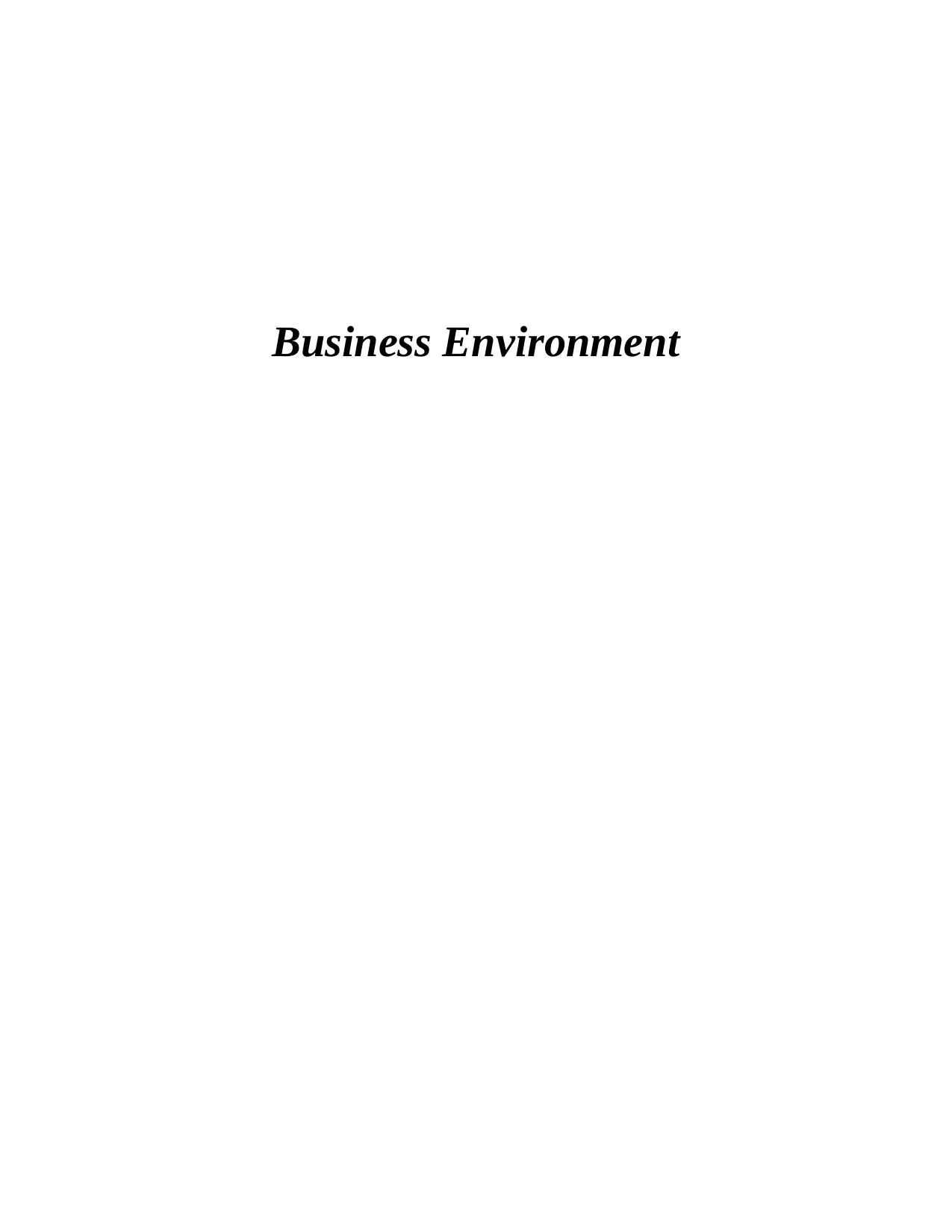
Business Environment
Paraphrase This Document
Need a fresh take? Get an instant paraphrase of this document with our AI Paraphraser
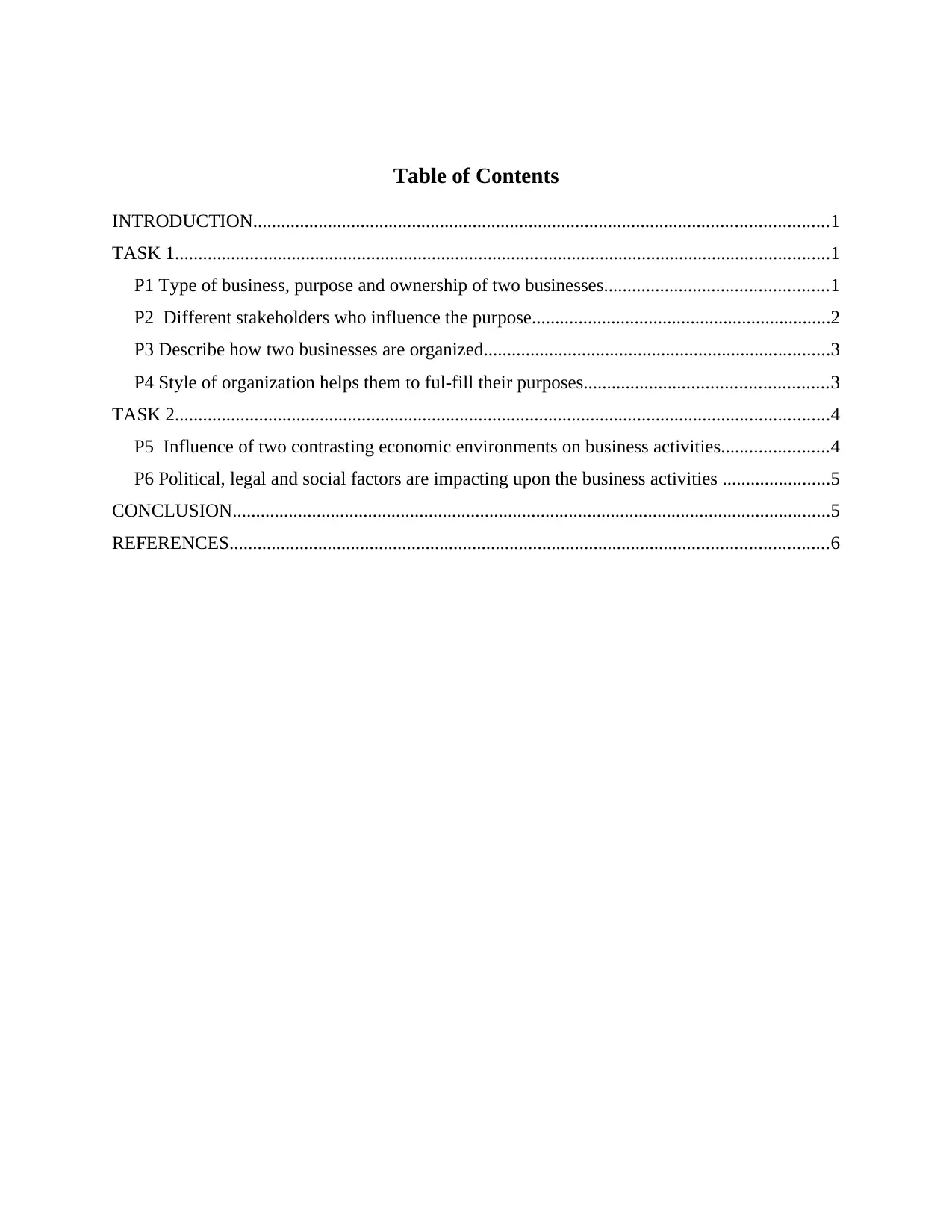
Table of Contents
INTRODUCTION...........................................................................................................................1
TASK 1............................................................................................................................................1
P1 Type of business, purpose and ownership of two businesses................................................1
P2 Different stakeholders who influence the purpose................................................................2
P3 Describe how two businesses are organized..........................................................................3
P4 Style of organization helps them to ful-fill their purposes....................................................3
TASK 2............................................................................................................................................4
P5 Influence of two contrasting economic environments on business activities.......................4
P6 Political, legal and social factors are impacting upon the business activities .......................5
CONCLUSION................................................................................................................................5
REFERENCES................................................................................................................................6
INTRODUCTION...........................................................................................................................1
TASK 1............................................................................................................................................1
P1 Type of business, purpose and ownership of two businesses................................................1
P2 Different stakeholders who influence the purpose................................................................2
P3 Describe how two businesses are organized..........................................................................3
P4 Style of organization helps them to ful-fill their purposes....................................................3
TASK 2............................................................................................................................................4
P5 Influence of two contrasting economic environments on business activities.......................4
P6 Political, legal and social factors are impacting upon the business activities .......................5
CONCLUSION................................................................................................................................5
REFERENCES................................................................................................................................6
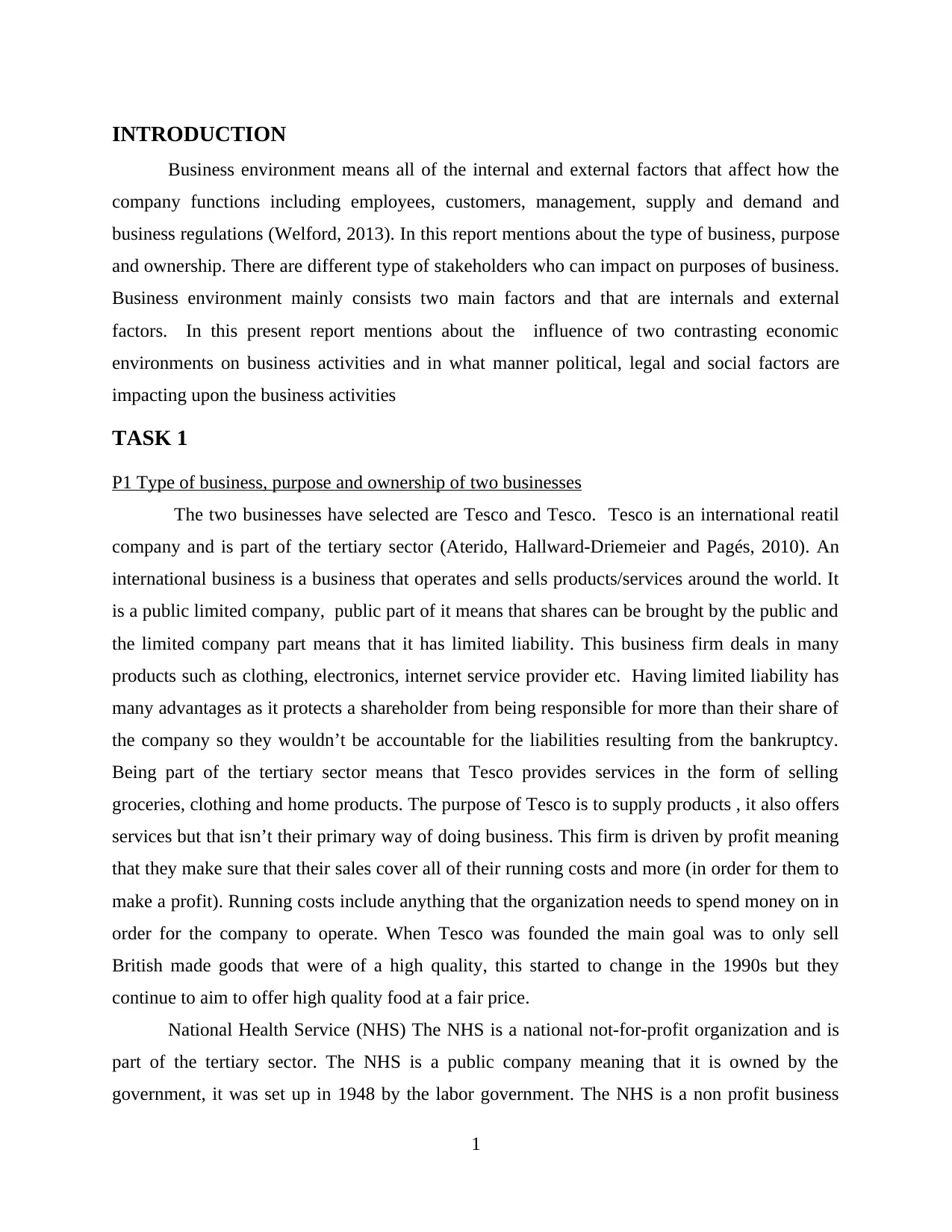
INTRODUCTION
Business environment means all of the internal and external factors that affect how the
company functions including employees, customers, management, supply and demand and
business regulations (Welford, 2013). In this report mentions about the type of business, purpose
and ownership. There are different type of stakeholders who can impact on purposes of business.
Business environment mainly consists two main factors and that are internals and external
factors. In this present report mentions about the influence of two contrasting economic
environments on business activities and in what manner political, legal and social factors are
impacting upon the business activities
TASK 1
P1 Type of business, purpose and ownership of two businesses
The two businesses have selected are Tesco and Tesco. Tesco is an international reatil
company and is part of the tertiary sector (Aterido, Hallward-Driemeier and Pagés, 2010). An
international business is a business that operates and sells products/services around the world. It
is a public limited company, public part of it means that shares can be brought by the public and
the limited company part means that it has limited liability. This business firm deals in many
products such as clothing, electronics, internet service provider etc. Having limited liability has
many advantages as it protects a shareholder from being responsible for more than their share of
the company so they wouldn’t be accountable for the liabilities resulting from the bankruptcy.
Being part of the tertiary sector means that Tesco provides services in the form of selling
groceries, clothing and home products. The purpose of Tesco is to supply products , it also offers
services but that isn’t their primary way of doing business. This firm is driven by profit meaning
that they make sure that their sales cover all of their running costs and more (in order for them to
make a profit). Running costs include anything that the organization needs to spend money on in
order for the company to operate. When Tesco was founded the main goal was to only sell
British made goods that were of a high quality, this started to change in the 1990s but they
continue to aim to offer high quality food at a fair price.
National Health Service (NHS) The NHS is a national not-for-profit organization and is
part of the tertiary sector. The NHS is a public company meaning that it is owned by the
government, it was set up in 1948 by the labor government. The NHS is a non profit business
1
Business environment means all of the internal and external factors that affect how the
company functions including employees, customers, management, supply and demand and
business regulations (Welford, 2013). In this report mentions about the type of business, purpose
and ownership. There are different type of stakeholders who can impact on purposes of business.
Business environment mainly consists two main factors and that are internals and external
factors. In this present report mentions about the influence of two contrasting economic
environments on business activities and in what manner political, legal and social factors are
impacting upon the business activities
TASK 1
P1 Type of business, purpose and ownership of two businesses
The two businesses have selected are Tesco and Tesco. Tesco is an international reatil
company and is part of the tertiary sector (Aterido, Hallward-Driemeier and Pagés, 2010). An
international business is a business that operates and sells products/services around the world. It
is a public limited company, public part of it means that shares can be brought by the public and
the limited company part means that it has limited liability. This business firm deals in many
products such as clothing, electronics, internet service provider etc. Having limited liability has
many advantages as it protects a shareholder from being responsible for more than their share of
the company so they wouldn’t be accountable for the liabilities resulting from the bankruptcy.
Being part of the tertiary sector means that Tesco provides services in the form of selling
groceries, clothing and home products. The purpose of Tesco is to supply products , it also offers
services but that isn’t their primary way of doing business. This firm is driven by profit meaning
that they make sure that their sales cover all of their running costs and more (in order for them to
make a profit). Running costs include anything that the organization needs to spend money on in
order for the company to operate. When Tesco was founded the main goal was to only sell
British made goods that were of a high quality, this started to change in the 1990s but they
continue to aim to offer high quality food at a fair price.
National Health Service (NHS) The NHS is a national not-for-profit organization and is
part of the tertiary sector. The NHS is a public company meaning that it is owned by the
government, it was set up in 1948 by the labor government. The NHS is a non profit business
1
⊘ This is a preview!⊘
Do you want full access?
Subscribe today to unlock all pages.

Trusted by 1+ million students worldwide
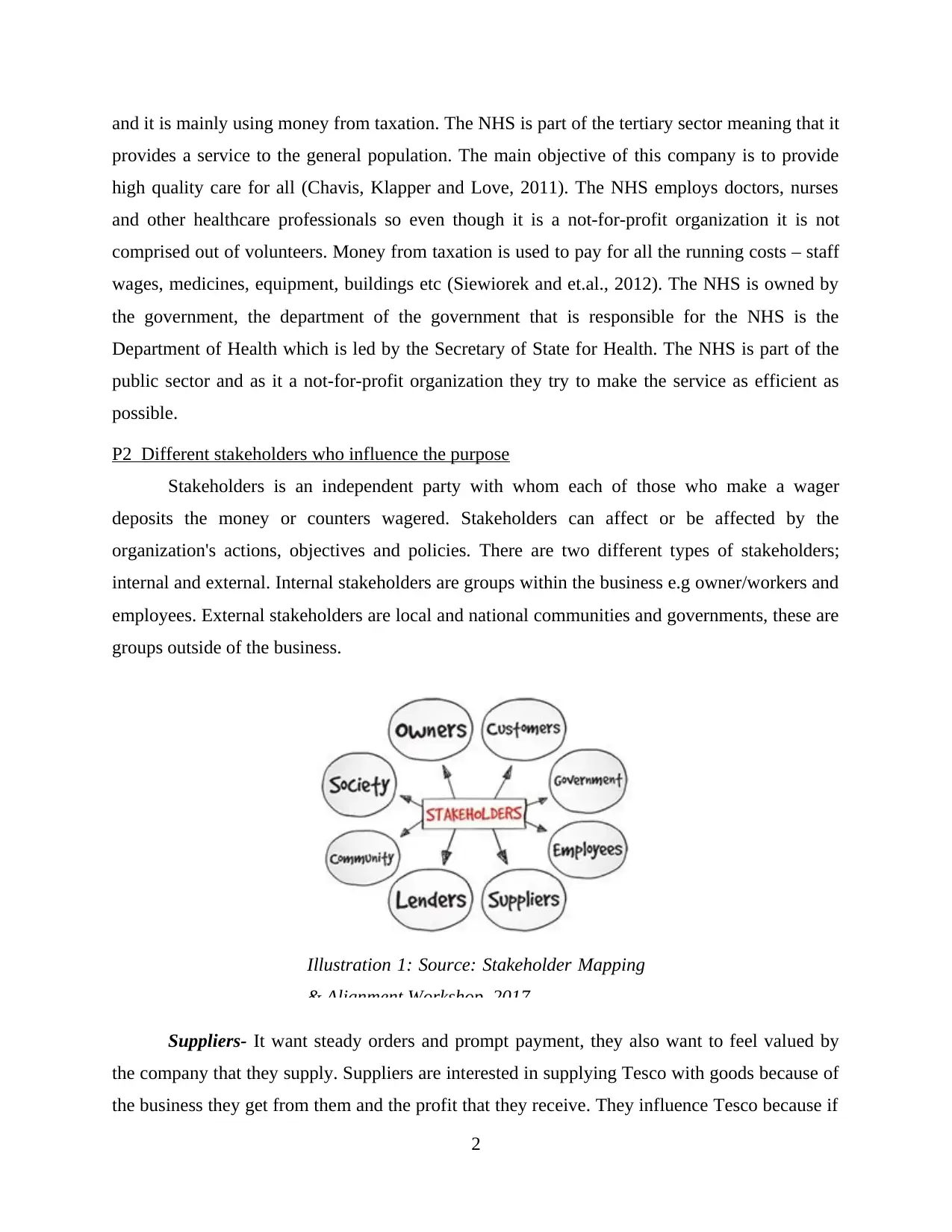
and it is mainly using money from taxation. The NHS is part of the tertiary sector meaning that it
provides a service to the general population. The main objective of this company is to provide
high quality care for all (Chavis, Klapper and Love, 2011). The NHS employs doctors, nurses
and other healthcare professionals so even though it is a not-for-profit organization it is not
comprised out of volunteers. Money from taxation is used to pay for all the running costs – staff
wages, medicines, equipment, buildings etc (Siewiorek and et.al., 2012). The NHS is owned by
the government, the department of the government that is responsible for the NHS is the
Department of Health which is led by the Secretary of State for Health. The NHS is part of the
public sector and as it a not-for-profit organization they try to make the service as efficient as
possible.
P2 Different stakeholders who influence the purpose
Stakeholders is an independent party with whom each of those who make a wager
deposits the money or counters wagered. Stakeholders can affect or be affected by the
organization's actions, objectives and policies. There are two different types of stakeholders;
internal and external. Internal stakeholders are groups within the business e.g owner/workers and
employees. External stakeholders are local and national communities and governments, these are
groups outside of the business.
Suppliers- It want steady orders and prompt payment, they also want to feel valued by
the company that they supply. Suppliers are interested in supplying Tesco with goods because of
the business they get from them and the profit that they receive. They influence Tesco because if
2
Illustration 1: Source: Stakeholder Mapping
& Alignment Workshop, 2017
provides a service to the general population. The main objective of this company is to provide
high quality care for all (Chavis, Klapper and Love, 2011). The NHS employs doctors, nurses
and other healthcare professionals so even though it is a not-for-profit organization it is not
comprised out of volunteers. Money from taxation is used to pay for all the running costs – staff
wages, medicines, equipment, buildings etc (Siewiorek and et.al., 2012). The NHS is owned by
the government, the department of the government that is responsible for the NHS is the
Department of Health which is led by the Secretary of State for Health. The NHS is part of the
public sector and as it a not-for-profit organization they try to make the service as efficient as
possible.
P2 Different stakeholders who influence the purpose
Stakeholders is an independent party with whom each of those who make a wager
deposits the money or counters wagered. Stakeholders can affect or be affected by the
organization's actions, objectives and policies. There are two different types of stakeholders;
internal and external. Internal stakeholders are groups within the business e.g owner/workers and
employees. External stakeholders are local and national communities and governments, these are
groups outside of the business.
Suppliers- It want steady orders and prompt payment, they also want to feel valued by
the company that they supply. Suppliers are interested in supplying Tesco with goods because of
the business they get from them and the profit that they receive. They influence Tesco because if
2
Illustration 1: Source: Stakeholder Mapping
& Alignment Workshop, 2017
Paraphrase This Document
Need a fresh take? Get an instant paraphrase of this document with our AI Paraphraser
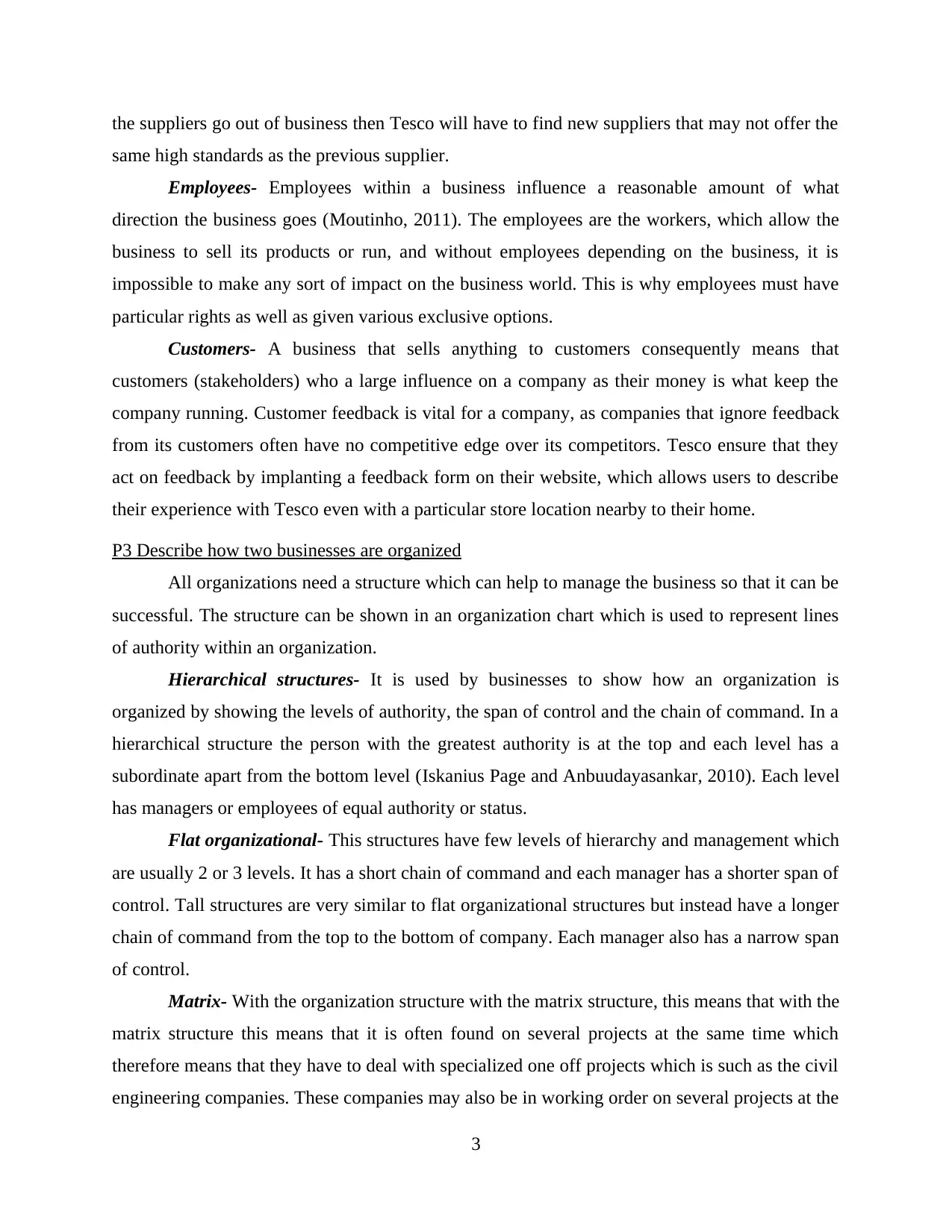
the suppliers go out of business then Tesco will have to find new suppliers that may not offer the
same high standards as the previous supplier.
Employees- Employees within a business influence a reasonable amount of what
direction the business goes (Moutinho, 2011). The employees are the workers, which allow the
business to sell its products or run, and without employees depending on the business, it is
impossible to make any sort of impact on the business world. This is why employees must have
particular rights as well as given various exclusive options.
Customers- A business that sells anything to customers consequently means that
customers (stakeholders) who a large influence on a company as their money is what keep the
company running. Customer feedback is vital for a company, as companies that ignore feedback
from its customers often have no competitive edge over its competitors. Tesco ensure that they
act on feedback by implanting a feedback form on their website, which allows users to describe
their experience with Tesco even with a particular store location nearby to their home.
P3 Describe how two businesses are organized
All organizations need a structure which can help to manage the business so that it can be
successful. The structure can be shown in an organization chart which is used to represent lines
of authority within an organization.
Hierarchical structures- It is used by businesses to show how an organization is
organized by showing the levels of authority, the span of control and the chain of command. In a
hierarchical structure the person with the greatest authority is at the top and each level has a
subordinate apart from the bottom level (Iskanius Page and Anbuudayasankar, 2010). Each level
has managers or employees of equal authority or status.
Flat organizational- This structures have few levels of hierarchy and management which
are usually 2 or 3 levels. It has a short chain of command and each manager has a shorter span of
control. Tall structures are very similar to flat organizational structures but instead have a longer
chain of command from the top to the bottom of company. Each manager also has a narrow span
of control.
Matrix- With the organization structure with the matrix structure, this means that with the
matrix structure this means that it is often found on several projects at the same time which
therefore means that they have to deal with specialized one off projects which is such as the civil
engineering companies. These companies may also be in working order on several projects at the
3
same high standards as the previous supplier.
Employees- Employees within a business influence a reasonable amount of what
direction the business goes (Moutinho, 2011). The employees are the workers, which allow the
business to sell its products or run, and without employees depending on the business, it is
impossible to make any sort of impact on the business world. This is why employees must have
particular rights as well as given various exclusive options.
Customers- A business that sells anything to customers consequently means that
customers (stakeholders) who a large influence on a company as their money is what keep the
company running. Customer feedback is vital for a company, as companies that ignore feedback
from its customers often have no competitive edge over its competitors. Tesco ensure that they
act on feedback by implanting a feedback form on their website, which allows users to describe
their experience with Tesco even with a particular store location nearby to their home.
P3 Describe how two businesses are organized
All organizations need a structure which can help to manage the business so that it can be
successful. The structure can be shown in an organization chart which is used to represent lines
of authority within an organization.
Hierarchical structures- It is used by businesses to show how an organization is
organized by showing the levels of authority, the span of control and the chain of command. In a
hierarchical structure the person with the greatest authority is at the top and each level has a
subordinate apart from the bottom level (Iskanius Page and Anbuudayasankar, 2010). Each level
has managers or employees of equal authority or status.
Flat organizational- This structures have few levels of hierarchy and management which
are usually 2 or 3 levels. It has a short chain of command and each manager has a shorter span of
control. Tall structures are very similar to flat organizational structures but instead have a longer
chain of command from the top to the bottom of company. Each manager also has a narrow span
of control.
Matrix- With the organization structure with the matrix structure, this means that with the
matrix structure this means that it is often found on several projects at the same time which
therefore means that they have to deal with specialized one off projects which is such as the civil
engineering companies. These companies may also be in working order on several projects at the
3
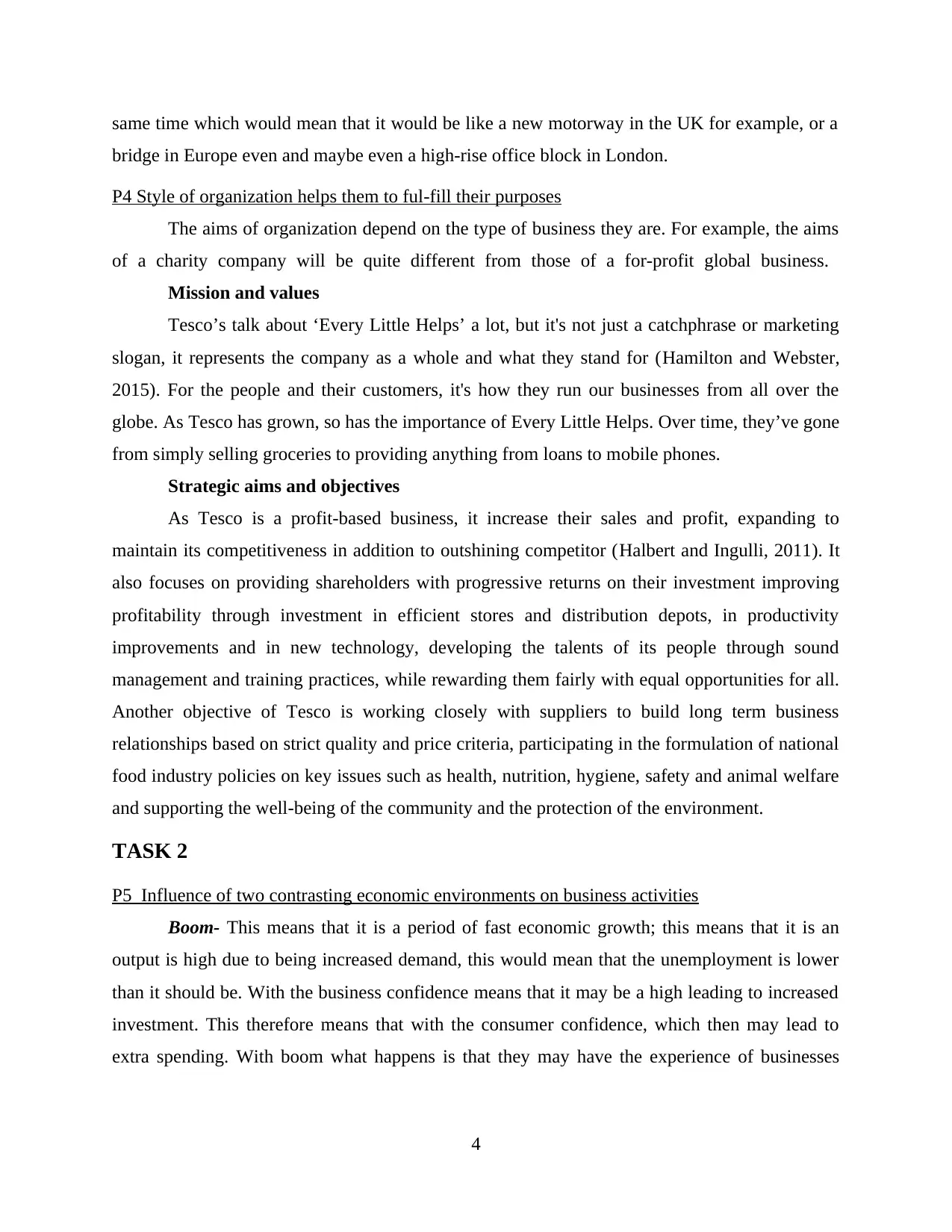
same time which would mean that it would be like a new motorway in the UK for example, or a
bridge in Europe even and maybe even a high-rise office block in London.
P4 Style of organization helps them to ful-fill their purposes
The aims of organization depend on the type of business they are. For example, the aims
of a charity company will be quite different from those of a for-profit global business.
Mission and values
Tesco’s talk about ‘Every Little Helps’ a lot, but it's not just a catchphrase or marketing
slogan, it represents the company as a whole and what they stand for (Hamilton and Webster,
2015). For the people and their customers, it's how they run our businesses from all over the
globe. As Tesco has grown, so has the importance of Every Little Helps. Over time, they’ve gone
from simply selling groceries to providing anything from loans to mobile phones.
Strategic aims and objectives
As Tesco is a profit-based business, it increase their sales and profit, expanding to
maintain its competitiveness in addition to outshining competitor (Halbert and Ingulli, 2011). It
also focuses on providing shareholders with progressive returns on their investment improving
profitability through investment in efficient stores and distribution depots, in productivity
improvements and in new technology, developing the talents of its people through sound
management and training practices, while rewarding them fairly with equal opportunities for all.
Another objective of Tesco is working closely with suppliers to build long term business
relationships based on strict quality and price criteria, participating in the formulation of national
food industry policies on key issues such as health, nutrition, hygiene, safety and animal welfare
and supporting the well-being of the community and the protection of the environment.
TASK 2
P5 Influence of two contrasting economic environments on business activities
Boom- This means that it is a period of fast economic growth; this means that it is an
output is high due to being increased demand, this would mean that the unemployment is lower
than it should be. With the business confidence means that it may be a high leading to increased
investment. This therefore means that with the consumer confidence, which then may lead to
extra spending. With boom what happens is that they may have the experience of businesses
4
bridge in Europe even and maybe even a high-rise office block in London.
P4 Style of organization helps them to ful-fill their purposes
The aims of organization depend on the type of business they are. For example, the aims
of a charity company will be quite different from those of a for-profit global business.
Mission and values
Tesco’s talk about ‘Every Little Helps’ a lot, but it's not just a catchphrase or marketing
slogan, it represents the company as a whole and what they stand for (Hamilton and Webster,
2015). For the people and their customers, it's how they run our businesses from all over the
globe. As Tesco has grown, so has the importance of Every Little Helps. Over time, they’ve gone
from simply selling groceries to providing anything from loans to mobile phones.
Strategic aims and objectives
As Tesco is a profit-based business, it increase their sales and profit, expanding to
maintain its competitiveness in addition to outshining competitor (Halbert and Ingulli, 2011). It
also focuses on providing shareholders with progressive returns on their investment improving
profitability through investment in efficient stores and distribution depots, in productivity
improvements and in new technology, developing the talents of its people through sound
management and training practices, while rewarding them fairly with equal opportunities for all.
Another objective of Tesco is working closely with suppliers to build long term business
relationships based on strict quality and price criteria, participating in the formulation of national
food industry policies on key issues such as health, nutrition, hygiene, safety and animal welfare
and supporting the well-being of the community and the protection of the environment.
TASK 2
P5 Influence of two contrasting economic environments on business activities
Boom- This means that it is a period of fast economic growth; this means that it is an
output is high due to being increased demand, this would mean that the unemployment is lower
than it should be. With the business confidence means that it may be a high leading to increased
investment. This therefore means that with the consumer confidence, which then may lead to
extra spending. With boom what happens is that they may have the experience of businesses
4
⊘ This is a preview!⊘
Do you want full access?
Subscribe today to unlock all pages.

Trusted by 1+ million students worldwide
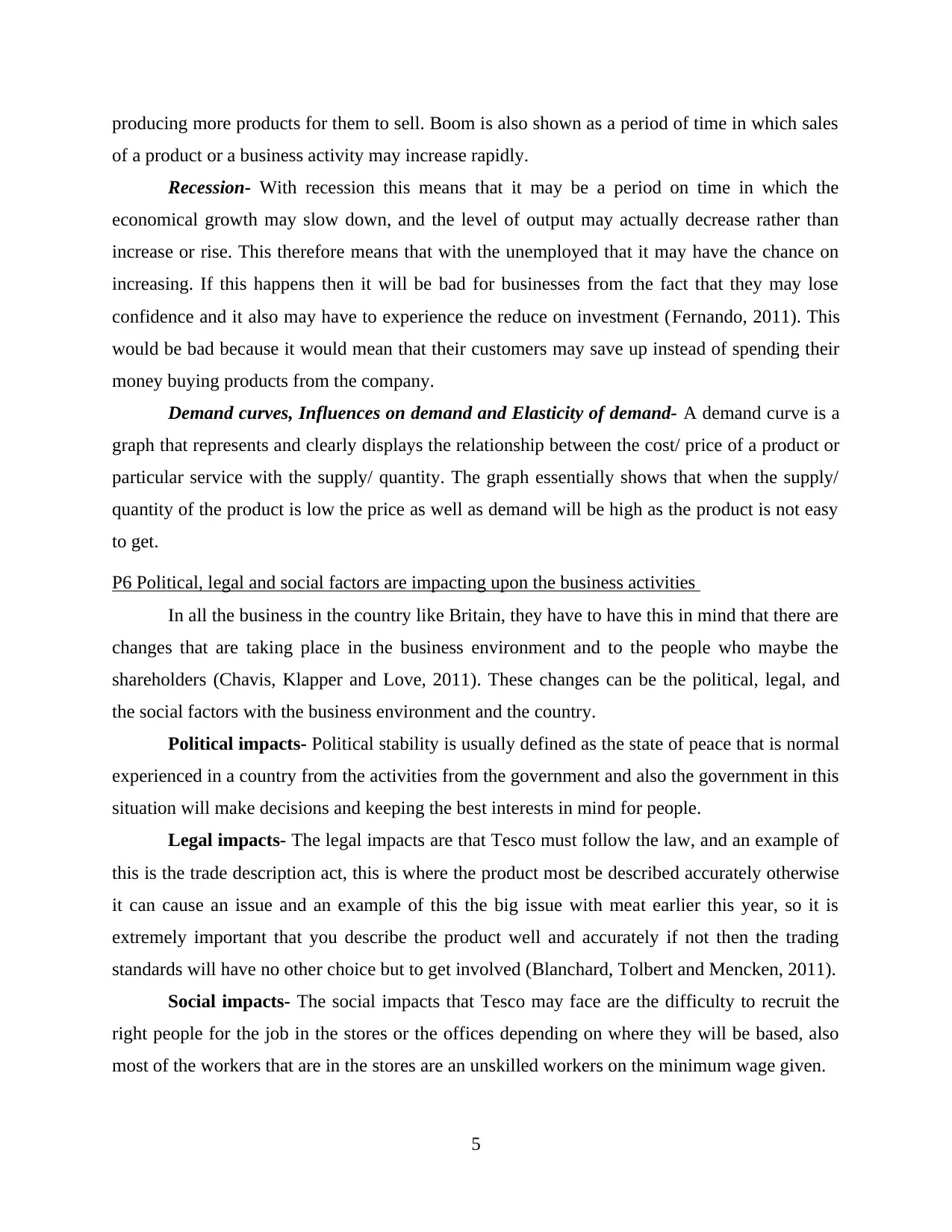
producing more products for them to sell. Boom is also shown as a period of time in which sales
of a product or a business activity may increase rapidly.
Recession- With recession this means that it may be a period on time in which the
economical growth may slow down, and the level of output may actually decrease rather than
increase or rise. This therefore means that with the unemployed that it may have the chance on
increasing. If this happens then it will be bad for businesses from the fact that they may lose
confidence and it also may have to experience the reduce on investment (Fernando, 2011). This
would be bad because it would mean that their customers may save up instead of spending their
money buying products from the company.
Demand curves, Influences on demand and Elasticity of demand- A demand curve is a
graph that represents and clearly displays the relationship between the cost/ price of a product or
particular service with the supply/ quantity. The graph essentially shows that when the supply/
quantity of the product is low the price as well as demand will be high as the product is not easy
to get.
P6 Political, legal and social factors are impacting upon the business activities
In all the business in the country like Britain, they have to have this in mind that there are
changes that are taking place in the business environment and to the people who maybe the
shareholders (Chavis, Klapper and Love, 2011). These changes can be the political, legal, and
the social factors with the business environment and the country.
Political impacts- Political stability is usually defined as the state of peace that is normal
experienced in a country from the activities from the government and also the government in this
situation will make decisions and keeping the best interests in mind for people.
Legal impacts- The legal impacts are that Tesco must follow the law, and an example of
this is the trade description act, this is where the product most be described accurately otherwise
it can cause an issue and an example of this the big issue with meat earlier this year, so it is
extremely important that you describe the product well and accurately if not then the trading
standards will have no other choice but to get involved (Blanchard, Tolbert and Mencken, 2011).
Social impacts- The social impacts that Tesco may face are the difficulty to recruit the
right people for the job in the stores or the offices depending on where they will be based, also
most of the workers that are in the stores are an unskilled workers on the minimum wage given.
5
of a product or a business activity may increase rapidly.
Recession- With recession this means that it may be a period on time in which the
economical growth may slow down, and the level of output may actually decrease rather than
increase or rise. This therefore means that with the unemployed that it may have the chance on
increasing. If this happens then it will be bad for businesses from the fact that they may lose
confidence and it also may have to experience the reduce on investment (Fernando, 2011). This
would be bad because it would mean that their customers may save up instead of spending their
money buying products from the company.
Demand curves, Influences on demand and Elasticity of demand- A demand curve is a
graph that represents and clearly displays the relationship between the cost/ price of a product or
particular service with the supply/ quantity. The graph essentially shows that when the supply/
quantity of the product is low the price as well as demand will be high as the product is not easy
to get.
P6 Political, legal and social factors are impacting upon the business activities
In all the business in the country like Britain, they have to have this in mind that there are
changes that are taking place in the business environment and to the people who maybe the
shareholders (Chavis, Klapper and Love, 2011). These changes can be the political, legal, and
the social factors with the business environment and the country.
Political impacts- Political stability is usually defined as the state of peace that is normal
experienced in a country from the activities from the government and also the government in this
situation will make decisions and keeping the best interests in mind for people.
Legal impacts- The legal impacts are that Tesco must follow the law, and an example of
this is the trade description act, this is where the product most be described accurately otherwise
it can cause an issue and an example of this the big issue with meat earlier this year, so it is
extremely important that you describe the product well and accurately if not then the trading
standards will have no other choice but to get involved (Blanchard, Tolbert and Mencken, 2011).
Social impacts- The social impacts that Tesco may face are the difficulty to recruit the
right people for the job in the stores or the offices depending on where they will be based, also
most of the workers that are in the stores are an unskilled workers on the minimum wage given.
5
Paraphrase This Document
Need a fresh take? Get an instant paraphrase of this document with our AI Paraphraser
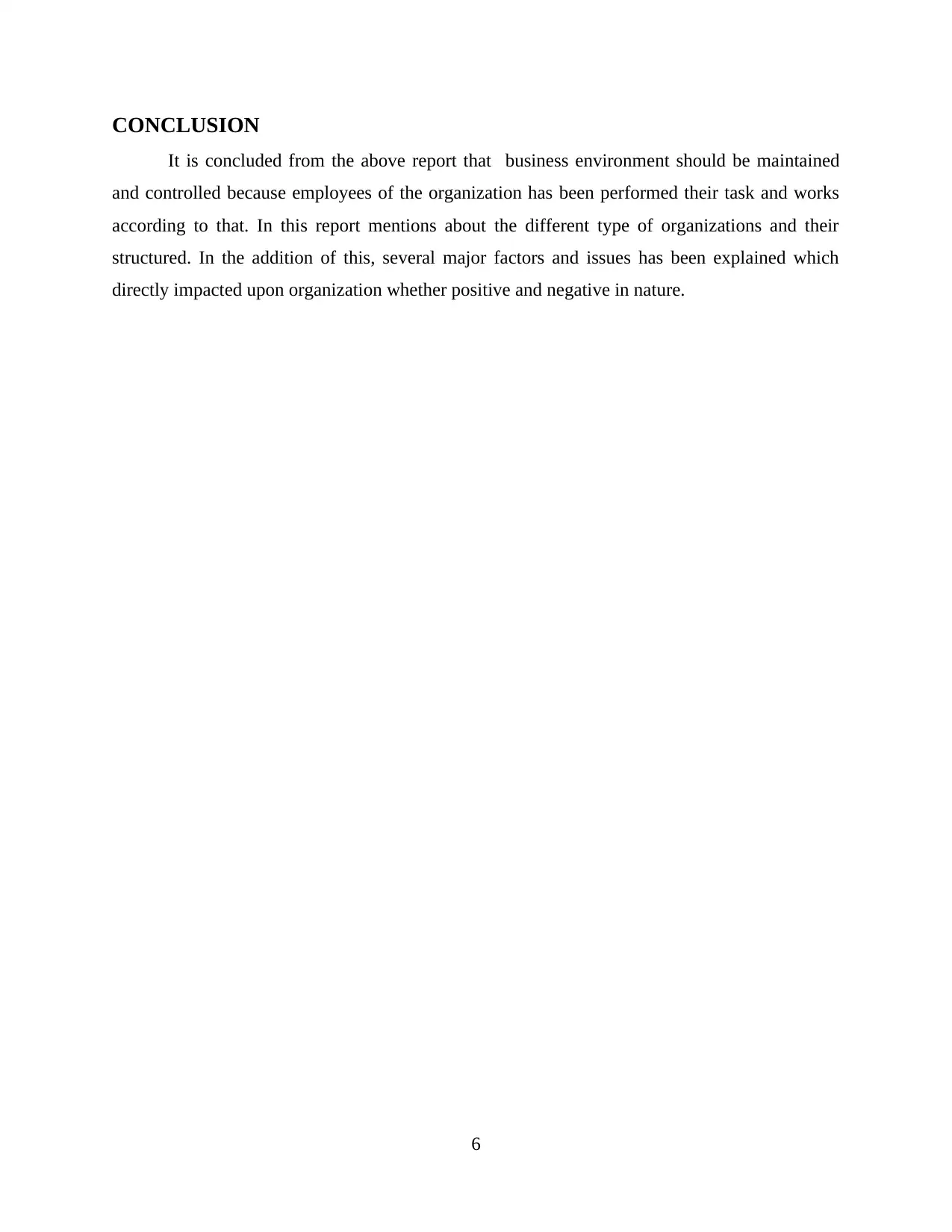
CONCLUSION
It is concluded from the above report that business environment should be maintained
and controlled because employees of the organization has been performed their task and works
according to that. In this report mentions about the different type of organizations and their
structured. In the addition of this, several major factors and issues has been explained which
directly impacted upon organization whether positive and negative in nature.
6
It is concluded from the above report that business environment should be maintained
and controlled because employees of the organization has been performed their task and works
according to that. In this report mentions about the different type of organizations and their
structured. In the addition of this, several major factors and issues has been explained which
directly impacted upon organization whether positive and negative in nature.
6
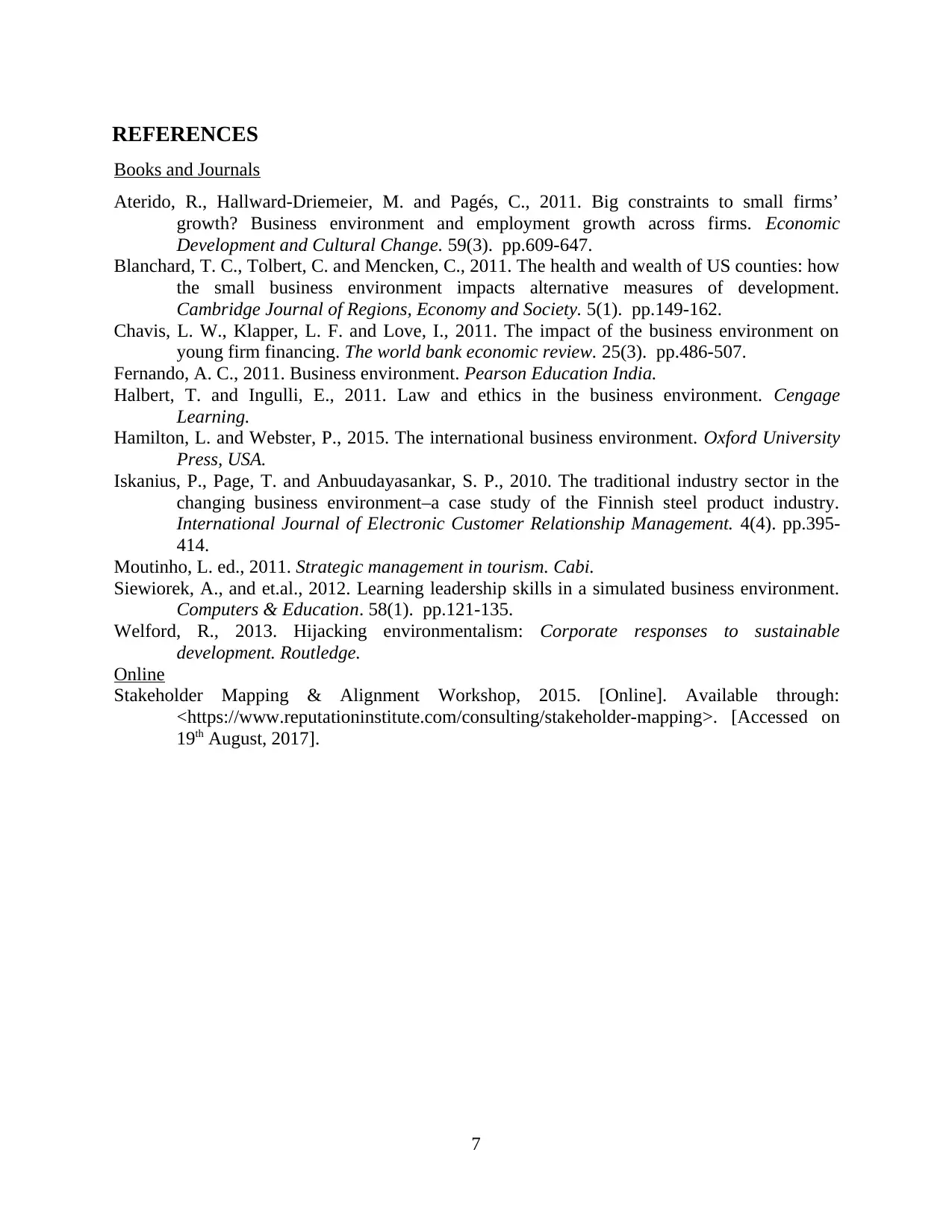
REFERENCES
Books and Journals
Aterido, R., Hallward-Driemeier, M. and Pagés, C., 2011. Big constraints to small firms’
growth? Business environment and employment growth across firms. Economic
Development and Cultural Change. 59(3). pp.609-647.
Blanchard, T. C., Tolbert, C. and Mencken, C., 2011. The health and wealth of US counties: how
the small business environment impacts alternative measures of development.
Cambridge Journal of Regions, Economy and Society. 5(1). pp.149-162.
Chavis, L. W., Klapper, L. F. and Love, I., 2011. The impact of the business environment on
young firm financing. The world bank economic review. 25(3). pp.486-507.
Fernando, A. C., 2011. Business environment. Pearson Education India.
Halbert, T. and Ingulli, E., 2011. Law and ethics in the business environment. Cengage
Learning.
Hamilton, L. and Webster, P., 2015. The international business environment. Oxford University
Press, USA.
Iskanius, P., Page, T. and Anbuudayasankar, S. P., 2010. The traditional industry sector in the
changing business environment–a case study of the Finnish steel product industry.
International Journal of Electronic Customer Relationship Management. 4(4). pp.395-
414.
Moutinho, L. ed., 2011. Strategic management in tourism. Cabi.
Siewiorek, A., and et.al., 2012. Learning leadership skills in a simulated business environment.
Computers & Education. 58(1). pp.121-135.
Welford, R., 2013. Hijacking environmentalism: Corporate responses to sustainable
development. Routledge.
Online
Stakeholder Mapping & Alignment Workshop, 2015. [Online]. Available through:
<https://www.reputationinstitute.com/consulting/stakeholder-mapping>. [Accessed on
19th August, 2017].
7
Books and Journals
Aterido, R., Hallward-Driemeier, M. and Pagés, C., 2011. Big constraints to small firms’
growth? Business environment and employment growth across firms. Economic
Development and Cultural Change. 59(3). pp.609-647.
Blanchard, T. C., Tolbert, C. and Mencken, C., 2011. The health and wealth of US counties: how
the small business environment impacts alternative measures of development.
Cambridge Journal of Regions, Economy and Society. 5(1). pp.149-162.
Chavis, L. W., Klapper, L. F. and Love, I., 2011. The impact of the business environment on
young firm financing. The world bank economic review. 25(3). pp.486-507.
Fernando, A. C., 2011. Business environment. Pearson Education India.
Halbert, T. and Ingulli, E., 2011. Law and ethics in the business environment. Cengage
Learning.
Hamilton, L. and Webster, P., 2015. The international business environment. Oxford University
Press, USA.
Iskanius, P., Page, T. and Anbuudayasankar, S. P., 2010. The traditional industry sector in the
changing business environment–a case study of the Finnish steel product industry.
International Journal of Electronic Customer Relationship Management. 4(4). pp.395-
414.
Moutinho, L. ed., 2011. Strategic management in tourism. Cabi.
Siewiorek, A., and et.al., 2012. Learning leadership skills in a simulated business environment.
Computers & Education. 58(1). pp.121-135.
Welford, R., 2013. Hijacking environmentalism: Corporate responses to sustainable
development. Routledge.
Online
Stakeholder Mapping & Alignment Workshop, 2015. [Online]. Available through:
<https://www.reputationinstitute.com/consulting/stakeholder-mapping>. [Accessed on
19th August, 2017].
7
⊘ This is a preview!⊘
Do you want full access?
Subscribe today to unlock all pages.

Trusted by 1+ million students worldwide
1 out of 9
Related Documents
Your All-in-One AI-Powered Toolkit for Academic Success.
+13062052269
info@desklib.com
Available 24*7 on WhatsApp / Email
![[object Object]](/_next/static/media/star-bottom.7253800d.svg)
Unlock your academic potential
Copyright © 2020–2025 A2Z Services. All Rights Reserved. Developed and managed by ZUCOL.





